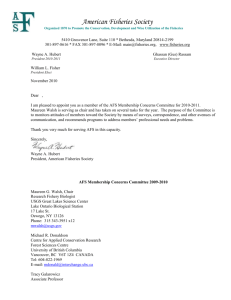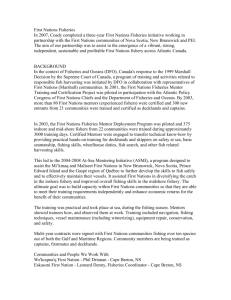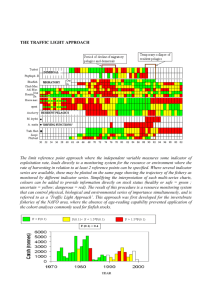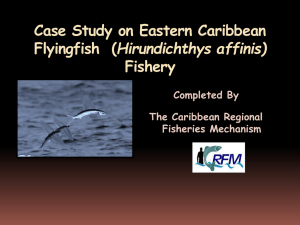Caribbean Regional Fisheries Mechanism
advertisement
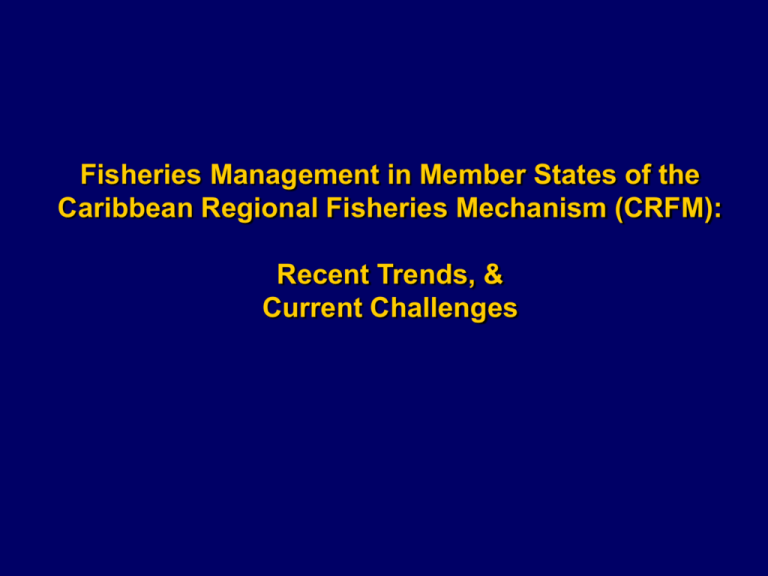
Fisheries Management in Member States of the Caribbean Regional Fisheries Mechanism (CRFM): Recent Trends, & Current Challenges PRESENTATION LAYOUT A. Industry Outline B. The Contribution of Regional Fisheries Initiatives of CARICOM to the Fisheries Management Process Within the Caribbean C. The Current Management Framework & Challenges A. Industry Outline Fisheries of CRFM States – Industry Outline • Fish is second highest source of protein • Shrimp, lobster and conch fisheries are most valuable for income generation • Significant revenue earner in some countries, e.g. Belize, & The Bahamas • Rural coastal fisheries most valuable for enhancing local food security and hence social stability • Key sector for providing employment opportunities for rural poor, socio-economically disadvantaged Fisheries of CRFM States – Industry Outline • Subsistence, artisanal, small-scale & semi-industrial components exist, contributing to varying extents to local availability, accessibility & utilization of fish products as food, and for generation of foreign exchange • Fisheries are also important for supporting the tourism industry - sport fishing (families of visitors), - snorkelling over reefs, - diving, - hotel restaurants) B. The Contribution of Regional Fisheries Initiatives of CARICOM to the Fisheries Management Process Within the Caribbean – CFRAMP (1991-2001) ICRAFD (1999-2004) CRFM (since 2002) CARICOM – Caribbean Community and Common Market Member States Belize, Guyana, Suriname, Jamaica, Trinidad Tobago, Barbados, Grenada, St. Lucia, St. Vincent & the Grenadines, The Bahamas St. Kitts & Nevis, Antigua & Barbuda, Dominica, Montserrat, Haiti Associate Member States - Anguilla, Bermuda, British Virgin islands, Cayman Islands, Turks and Caicos islands OBJECTIVES – (i) Economic cooperation (ii) Coordination of foreign policy (iii) Provision of common services in health, education, culture, communications, industrial relations CARICOM CFRAMP/ICRAFD CRFM – Caribbean Regional Fisheries Mechanism PRIORITY AREAS 1. Assessment & management of shared resources 2. Assessment & management of national resources 3. Regional & national capacity building & institutional strengthening 4. Regional and national project development & management 5. Regional representation in international fora 6. Regional & national socio-economics planning. C. The Current Management Framework & Challenges TYPICAL FISHERIES MANAGEMENT TEAM IN CRFM STATE DIRECT USERS OF THE RESOURCE & OTHER STAKEHOLDERS (e.g. FISHERS, FISHERFOLK GROUPS, VENDORS, PROCESSORS) Fisheries Director DATA COLLECTORS, DATA MANAGERS Policy/ Decision Makers (Minister/government) Fisheries Director FISHERIES SCIENTISTS FISHERIES MANAGEMENT AT REGIONAL LEVEL DIRECT USERS OF THE RESOURCE & OTHER STAKEHOLDERS (E.G. FISHERS, FISHERFOLK GROUPS, PROCESSORS) Fisheries Directors DATA COLLECTORS, DATA MANAGERS Policy/ Decision Makers (CRFM Ministerial Council) ANNUAL SCIENTIFIC MEETING (FISHERIES SCIENTISTS) Caribbean Fisheries Forum (Fisheries Directors) Fisheries Directors Regional fisherfolk organisation MANAGEMENT OBJECTIVES 1. BIOLOGICAL - ensure sustainable use - promote stock recovery - exploit at maximum sustainable yield - protect juveniles - protect berried females (lobster) - rationalize fishing effort (recreational fishery) 2. ECOLOGICAL - protection of the ecosystem /habitat recovery - minimize land-based pollution - encourage artificial areas as alternative to rebuilding stock (lobster) 3. ECONOMIC - increase revenues from recreational fishery - reduce imports - maximize employment opportunities - increase foreign exchange 4. SOCIAL support territorial user rights approach - maximize benefits to all stakeholders - minimize conflict between artisanal and non-artisanal components Data Collected to Monitor Management Objectives (i) (ii) (iii) (iv) Catch Nominal effort (number of fishing trips/ trip hours) Biological Other – social, economic, technological, % live coral cover, faecal coliform levels CURRENT FISHERIES MANAGEMENT QUESTIONS/ CONCERNS REEF 1) DEVELOPING USEFUL REFERENCE POINTS 2) THE EFFECT OF ANTHROPOGENIC EFFECTS ON STOCKS 3) WHAT MEASURES COULD BE PUT IN PLACE TO REDUCE OVER-EXPLOITTAION OF REEF FISHERIES? 4) HOW ARE DECLINES IN REEF QUALITY RELATED TO ABUNDANCE OF KEY SPECIES? DEEP SLOPE 1) WHEN SHOULD WE PHASE OUT THE USE OF TRAPS? 2) HOW DO WE STOP ILLEGAL FISHING? LOBSTER 1) HOW EFFECTIVE ARE MINIMUM SIZE LIMITS IN ENHANCING STOCK? 2) HOW EFFECTIVE IS CLOSED SEASON IN ENHANCING STOCK? 3) THE EFFECT OF ANTHROPOGENIC EFFECTS ON STOCKS 4) HOW EFFICIENT ARE MARINE RESERVES IN ENHANCING SPAWNING STOCK BIOMASS? 5) WHAT IS THE SOCIO-ECONOMIC VALUE OF THE FISHERY? 6) WHAT ARE THE CHANGES IN RELATIVE ABUNDANCE OVER TIME? CURRENT FISHERIES MANAGEMENT QUESTIONS/ CONCERNS QUEEN CONCH 1) HOW EFFECTIVE ARE MINIMUM SIZE LIMITS IN ENHANCING STOCK? 2) IS THE CLOSED SEASON EFFECTIVE? 3) THE EFFECT OF ANTHROPOGENIC EFFECTS ON STOCKS 4) HOW EFFICIENT ARE MARINE RESERVES IN ENHANCING SPAWNING STOCK BIOMASS? 5) IS NEARSHORE POLLUTION AFFECTING RESOURCE ABUNDANCE AND HEALTH? LARGE PELAGIC FINFISH 1) DEVELOPING USEFUL REFERENCE POINTS 2) EFFECT OF ILLEGAL FOREIGN FISHING ON MIGRATORY AND LOCAL STOCKS 3) IS THERE ANY ROOM FOR FURTHER EXPANSION OF THIS FISHERY 4) CHANGES IN RELATIVE ABUNDANCE OVER TIME? SMALL PELAGIC FINFISH 1) DEVELOPING USEFUL REFERENCE POINTS 2) IS THERE A CORRELATION BETWEEN WATER QUALITY AND ABUNDANCE OF SPECIES? 3) TO WHAT DEGREE MESH SIZE LIMITS PROTECT JUVENILES? CURRENT FISHERIES MANAGEMENT QUESTIONS/ CONCERNS SHRIMP 1) HOW TO RESTRICT CONFLICT BETWEEN FISHERY SECTORS (TRAWLERS AND ARTISANAL FLEET) 2) WHEN/WHERE BEST TO APPLY A CLOSED SEASON AND/OR CLOSED AREA REGULATION? 3) WHAT IS THE BIOMASS OF THIS FISHERY/SIZE OF THE STOCK? 4) HOW AND WHEN TO PROTECT THE NURSERY HABITAT FOR SHRIMP STOCKS? 5) HOW MANY SHRIMP TRAWLERS CAN FISH THE STOCK? 6) FOR HOW LONG CAN THE STOCK BE FISHED IN ANY GIVEN YEAR? GROUNDFISH 1) IS A MESH SIZE REGULATION NECESSARY AND IF SO, WHAT WOULD IT BE? 2) WHAT IS THE BIOMASS OF THIS FISHERY? SEA TURTLES 1) TO WHAT EXTENT CAN CO-MANAGEMENT HELP IN INCREASING LEVELS OF CONSERVATION IN NEVIS? 2) WHAT LEVELS OF EXPLOITATION WOULD BE SUSTAINABLE AT THE POPULATION LEVEL 3) WHAT IS THE STATUS OF THE STOCK? CURRENT FISHERIES MANAGEMENT QUESTIONS/ CONCERNS MAMMALS 1) DEVELOPING USEFUL REFERENCE POINTS 2) INFORMATION ON CURRENT STATE OF SMALL MAMMAL STOCKS 3) INFORMATION ON CURRENT STATE OF LARGE MAMMAL STOCKS GENERAL 1) WHAT IS THE APPROPRIATE LEVEL OF FISHING EFFORT TO AVOID OVER-EXPLOITATION OF THE RESOURCES AND ATTAIN ECONOMIC EFFICIENCY IN THE OPERATION OF THE FLEETS? 2) WHAT IMPACT DOES POLLUTION HAVE ON THE STATUS OF THE STOCKS? 3) WHAT IS THE ROLE OF FISHERIES IN THE SOCIOECONOMIC WELL-BEING OF COMMUNITIES? Challenges Faced in Achieving Management Objectives • • • • • • • • • Still ‘open access’ fisheries Incomplete data for monitoring management objectives Uncertain/ over-simplified fishery assessment analyses Need for risk assessment & development of ecologically adapted management/ more flexible management systems Need to implement precautionary approach Need to implement ecosystem-based approach to management Inadequate linkages to integrated coastal zone management initiatives GEC issues generally not accounted for in development of policy and management objectives - ADAPTIVE MANGEMENT, in response to short-term changes - ADAPTED MANAGEMENT, in response to envisaged longerterm changes GEC issues generally not addressed by current fishery analytical models – needed to support decision-making




